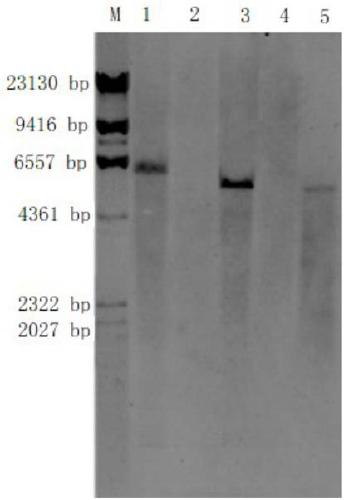Flanking sequences of transgenic insect-resistant herbicide-resistant maize CM8101 exogenous insertion fragment and application thereof
A technology of transgenic corn and exogenous insertion, which is applied in the field of plant biology and can solve unrealistic problems
- Summary
- Abstract
- Description
- Claims
- Application Information
AI Technical Summary
Problems solved by technology
Method used
Image
Examples
Embodiment 1
[0035] Example 1 Integration of the target gene in the genome of insect-resistant and herbicide-resistant transgenic maize CM8101
[0036] 1. Southern blot hybridization detection technology
[0037] (1) Agarose electrophoresis: Take a certain amount of DNA sample to be tested, and digest 10-20 μg with an appropriate restriction endonuclease; after digestion, perform electrophoresis on agarose gel; after electrophoresis, transfer to membrane.
[0038] (2) Blot transfer: cut the gel and mark it (excision in the lower left corner) for easy positioning, then place the gel in a container, depurinate it with 0.25M HCl for 10 min; soak the gel in an appropriate amount of denaturing solution, Place it at room temperature for 30 minutes to denature it, and shake gently without interruption; cut the filter paper and nylon membrane to the same size as the glue, and immerse the nylon membrane in the transfer buffer for 30 minutes to balance; spread layer by layer, leaving no air bubbles ...
Embodiment 2
[0054] Example 2 The establishment of exogenous insertion sequence analysis and specific PCR detection method
[0055] The flanking genome sequence of the inserted fragment and the sequences inserted into the maize genome near the 5' end and 3' end were obtained by optimized Tail-PCR method, and the transformant-specific PCR detection method was determined according to the flanking sequence.
[0056] 1. Tail-PCR captures flanking sequences
[0057] According to the hiTAIL-PCR method reported by Liu Yaoguang et al., the specific primers for hiTAIL-PCR were designed according to the sequence of the 5' end and 3' end of the vector. The nucleotide sequence and the length of the amplified fragment are shown in Table 3. See Table 4 for arbitrary degenerate primers AD1-n (n is 1 to 4), AC-1 and AD6 used in hiTAIL-PCR.
[0058] Table 3 specific primers
[0059]
[0060] Table 4 Arbitrary degenerate primers AD1-n, AC1 and AD6
[0061]
[0062] The PCR reaction system of each s...
Embodiment 3
[0085] Example 3 Quantitative detection of target protein in different tissues in different periods
[0086] 1. ELISA quantitative detection technology
[0087] Each material was sampled in different periods and different tissues, and 3 strains were taken from each tissue. Take 0.1g and simply cut into 4-8 segments. Put it into liquid nitrogen for quick freezing, and put each material into a sealed bag, and put them collectively into -80 for storage. The Cry1Ab / Ac kit produced by Agdia Company in the United States was used. The analysis method was operated according to the specific kit instructions. The analysis results were based on the expressed gene protein as a percentage of the sample tissue weight ng protein / g weight and the soluble protein percentage as a mg protein / g weight per gram. Heavy representation. Different tissue samples were taken from different stages of field growth, and 3 plants were taken from each tissue for detection.
[0088] Weigh 0.1 g of the tis...
PUM
 Login to View More
Login to View More Abstract
Description
Claims
Application Information
 Login to View More
Login to View More - R&D Engineer
- R&D Manager
- IP Professional
- Industry Leading Data Capabilities
- Powerful AI technology
- Patent DNA Extraction
Browse by: Latest US Patents, China's latest patents, Technical Efficacy Thesaurus, Application Domain, Technology Topic, Popular Technical Reports.
© 2024 PatSnap. All rights reserved.Legal|Privacy policy|Modern Slavery Act Transparency Statement|Sitemap|About US| Contact US: help@patsnap.com










